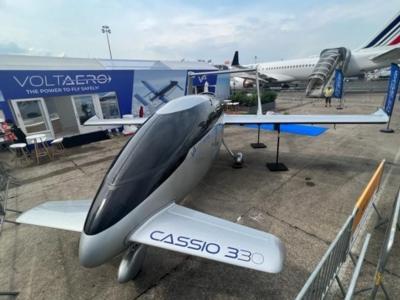The Rise of Regional AAM In the E.U.
VoltAero, the French designer and manufacturer of electric aircraft, has signed a Memorandum of Understanding (MoU) with Power Up, an 18-member consortium founded for purpose of facilitating the debut of Advanced Air Mobility (AAM) in Europe and accelerating the proliferation thereof.

VoltAero, by dint of subject MoU, has committed to conducting test-flights, primarily in the Netherlands, by which the company will define operational procedures germane to its eVTOL platform, AAM infrastructure, and inter-regional air-transportation operated by electric aircraft.
Additional aviation and mobility concerns party to the Power Up MoU include Eindhoven Airport (EIN), Groningen Airport Eelde (GRQ), Lelystad Airport (LEY), Maastricht Aachen Airport (MST), and Rotterdam The Hague Airport (RTM), KLM Royal Dutch Airlines, the Dutch Railways, the Netherlands Aerospace Center, and a number of consultancies.
Speaking at the Power Up MoU signing event in Eindhoven, VoltAero CTO-CEO Jean Botti stated: “The Power Up initiative is an excellent opportunity to show how Cassio and other e-airplanes offer the solution to introducing a new era of efficient air-mobility with low-carbon emissions and reduced noise. As we progress toward Cassio’s production and service introduction, we are proud to partner with the Power Up initiative in pioneering sustainable aviation.”
Dubbed the Cassio 330, VoltAero’s initial offering is a single-pilot, four-passenger, Short Take-off and Landing (STOL) aircraft, the numerical designation of which pertains to the machine’s combined hybrid-electric power-rating of—more or less—330-kilowatts.
The hybrid-electric propulsion scheme by which the Cassio 330 is compelled aloft comprises a 221-horsepower, four-cylinder Kawasaki reciprocating engine and a 241-horsepower Safran ENGINeUS smart electric motor. The latter powerplant drives a single, two-meter-diameter, aft-facing, centerline-thrusting pusher-propeller.
The Cassio’s electrical system provides power during taxi, takeoff, primary flight, and landing. The Kawasaki internal-combustion engine recharges the aircraft’s batteries while in-flight and serves as a backup in the event of electrical malfunction.

In all, VoltAero plans to produce three iterations of its Cassio design, each sharing a high degree of modularity and commonality. Certification of the Cassio 330 will be followed by the releases and certifications of the six-seat Cassio 480, with a combined electric-hybrid power output of (you guessed it) 480-kilowatts, and the 10-12-seat, Cassio 660, with a combined electric-hybrid power output of …
VoltAero’s design for the Cassio aircraft family is based on a sleek, aerodynamically-optimized fuselage, a forward canard, and an aft-set wing with twin booms that support a high-set horizontal tail—after the fashion of a radically modernized, Cessna 337 Skymaster.
VoltAero posits its family of Cassio aircraft will factor prominently in near-future regional, commercial, air-taxi/charter, cargo, postal delivery, and medical evacuation operations.
VoltAero’s Cassio aircraft will be built in a new 7,874-square-foot production facility on the Rochefort Charente-Maritime Airport (LRH) in France’s southwestern Nouvelle-Aquitaine region. Construction of the structure commenced in October 2023.
 Senator Pushes FAA to Accelerate Rocket Launch Licensing
Senator Pushes FAA to Accelerate Rocket Launch Licensing Classic Aero-TV: RJ Gritter - Part of Aviations Bright New Future
Classic Aero-TV: RJ Gritter - Part of Aviations Bright New Future Aero-FAQ: Dave Juwel's Aviation Marketing Stories -- ITBOA BNITBOB
Aero-FAQ: Dave Juwel's Aviation Marketing Stories -- ITBOA BNITBOB ANN's Daily Aero-Linx (10.27.24)
ANN's Daily Aero-Linx (10.27.24) ANN's Daily Aero-Term (10.27.24): Clearance Void If Not Off By (Time)
ANN's Daily Aero-Term (10.27.24): Clearance Void If Not Off By (Time)




